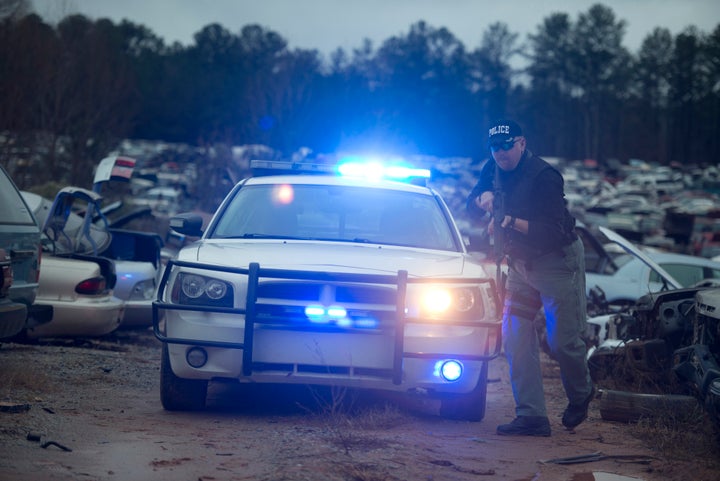
WASHINGTON ― For the first time since Ferguson, Missouri, became synonymous with police brutality, the Supreme Court will take a hard look at what the Constitution has to say about excessive force, exploring if there are legal mechanisms that may help victims hold officers accountable for violating their civil rights.
Without much fanfare, the court last week agreed to hear County of Los Angeles v. Mendez ― a case that, on its facts alone, is not unlike the long parade of incidents where people of color are targeted by officers who are simply too quick to pull the trigger.
The case is significant because it will offer the justices and the public a chance to learn about a quirk in the law of policing. The so-called “provocation rule,” which only applies in the nine states covered by the U.S. Court of Appeals for the 9th Circuit, opens up officers to liability if they act unconstitutionally in the lead-up to their encounters with everyday citizens.
“I’m optimistic that the Supreme Court will see this the same way as I do,” said Leonard Feldman ― whose clients, Angel and Jennifer Mendez, won a $4 million verdict after a federal judge concluded that two Los Angeles County sheriff deputies weren’t entitled to legal immunity for their misconduct.
The Mendezes’ near-fatal experience seems all too familiar. While looking for an armed fugitive and without a warrant, the two county deputies broke into their wooden shack, which was located in the backyard of a friend’s house and that looked every bit a private residence.
“The deputies were told that a couple was living behind the house, and the shack itself was surrounded by an air conditioning unit, electric cord, water hose, and clothes locker,” said the 9th Circuit in a ruling upholding the verdict against the officers.
Startled in part by a BB gun that Angel kept by his bedside, the officers fired fifteen rounds at the couple. Jennifer, who was five months pregnant at the time, was shot in the back, and Angel, who got hit several times, lost his right leg below the knee as a result of the injuries.
Both survived and sued the officers and Los Angeles county in federal court, claiming a violation of their constitutional rights.
This is where the case ― and the provocation rule ― stand out and may have led the Supreme Court to get interested in the case. The two lower courts found that the Mendezes’ shooting itself was reasonable, under a doctrine developed in 1989 by the high court that largely shields officers who resort to excessive force whenever they fear for their lives.
But the 9th Circuit, alone in the nation in this area, has a counter-doctrine ― the provocation rule. Under it, any constitutional violation that provokes a law-abiding citizen can create liability for a public official. And here, the courts found that the unannounced, warrantless entry into the Mendezes’ abode ― a violation of the Fourth Amendment in itself ― provoked Angel to motion for his BB gun.
This “incompetence,” Feldman said, led to the shooting that severely injured his clients.
“This is a situation where one of the undisputed facts of the case is that they did nothing wrong and were very significantly harmed.”
- Leonard Feldman, attorney for Angel and Jennifer Mendez
Seth Stoughton, a University of South Carolina law professor and former police officer who specializes in the law of excessive force, cautioned that, as framed, the Mendez case likely won’t disturb the constitutional standard of Graham v. Connor, the “reasonableness” rule the Supreme Court fashioned in 1989.
“It’s generally not a good sign when the court agrees to hear a case about a rule that only one circuit follows,” Stoughton said. He added that, in a best-case scenario, the justices will simply leave the provocation rule alone and note that it’s not inconsistent with the current constitutional ground rules for law enforcement.
Scott Greenfield, a criminal defense attorney who writes extensively on criminal law and procedure, said the provocation rule is simply too good to be spared by the Supreme Court.
“Perhaps the Court will make this the law of the land, but then, smart money is on the death of the provocation doctrine,” he wrote Tuesday on Fault Lines, a criminal justice blog. “It just makes too much sense.”
It is no secret to observers of the court that the justices are reluctant to develop new rules for use-of-force incidents. Last year, in a Texas case that immunized an officer who shot and killed a Latino driver, Justice Sonia Sotomayor sounded the alarm that she and her colleagues weren’t doing enough to set new rules of engagement for officers.
“By sanctioning a ‘shoot first, think later’ approach to policing, the court renders the protections of the Fourth Amendment hollow,” Sotomayor wrote in a lone dissenting opinion. The case was decided summarily and without oral arguments.
The Mendez case, on the other hand, will get full briefing and oral arguments ― and may very well draw the attention of advocates and outside groups who may want to educate the court on how the Constitution plays out on the ground. Stoughton said he may do just that.
“Honestly, I’m worried about this one,” he said in a follow-up email. He predicted a likely 4-to-4 split among conservative and liberal justices. (The Supreme Court has had a vacant seat since the late Justice Antonin Scalia died in February.)
Feldman, the Mendezes’ lawyer, has another worry: that the court’s involvement will only delay justice for his clients.
“This is a situation where one of the undisputed facts of the case is that they did nothing wrong and were very significantly harmed,” he said. “Not just pain and suffering, but medical bills. The continuing review of the case delays their ability to move forward.”
The Supreme Court is expected to hear County of Los Angeles v. Mendez early next year.
